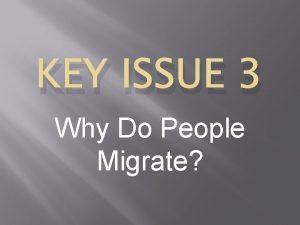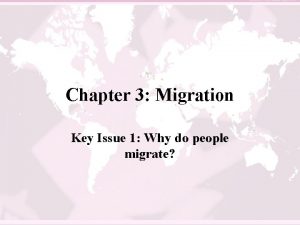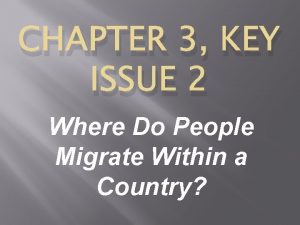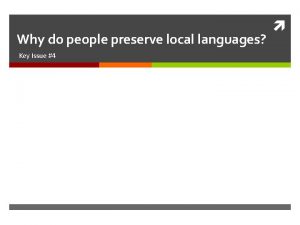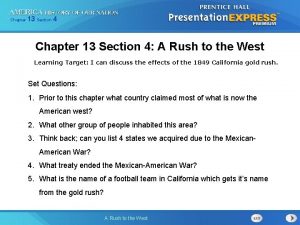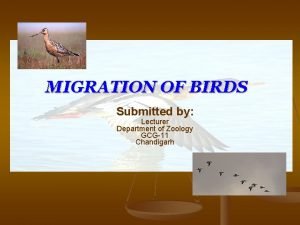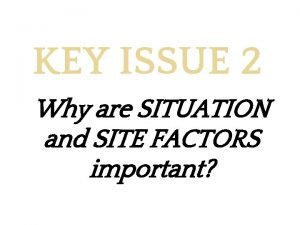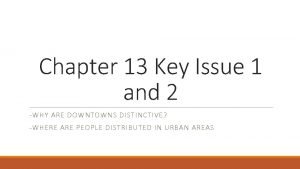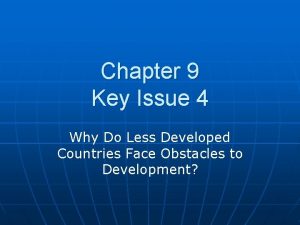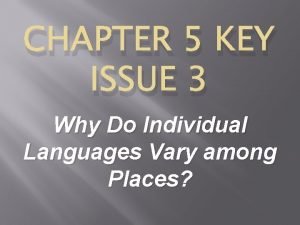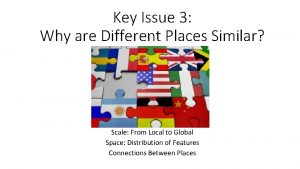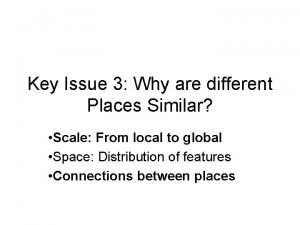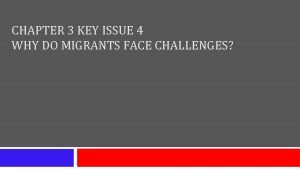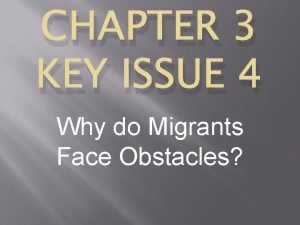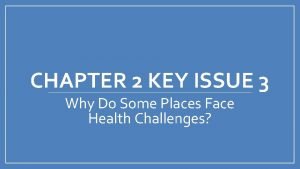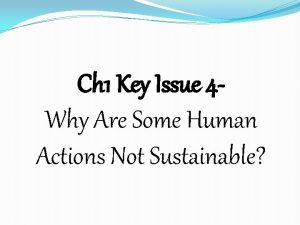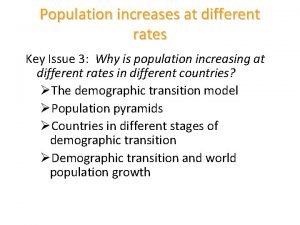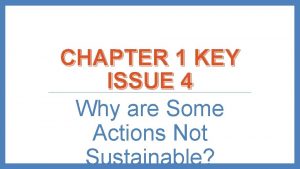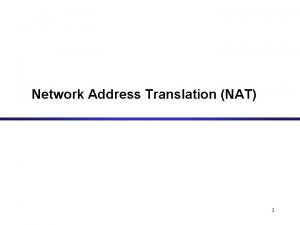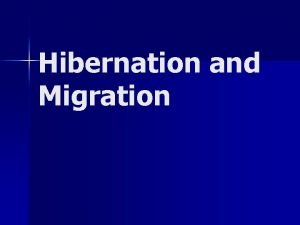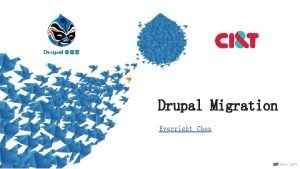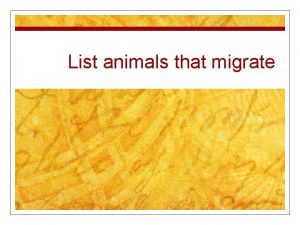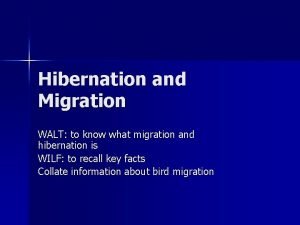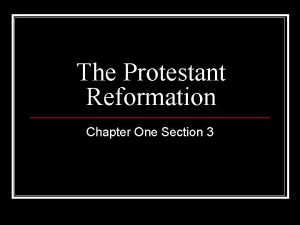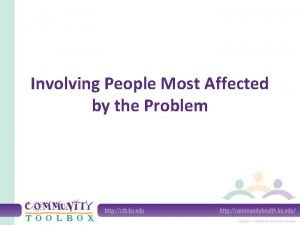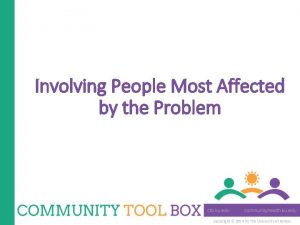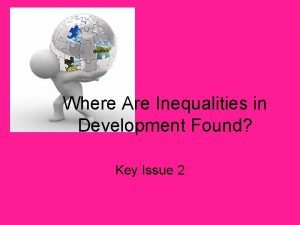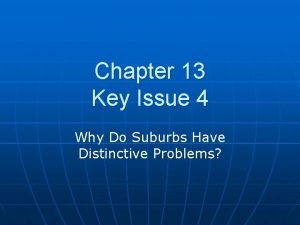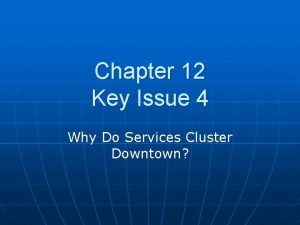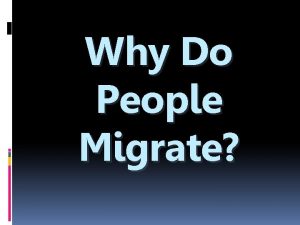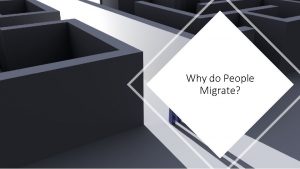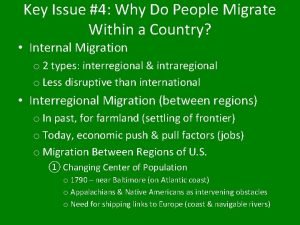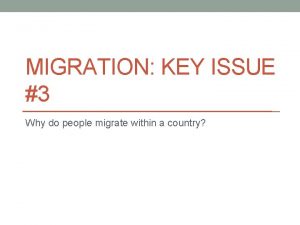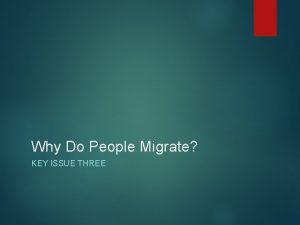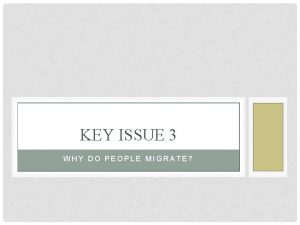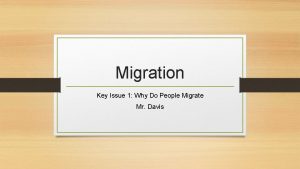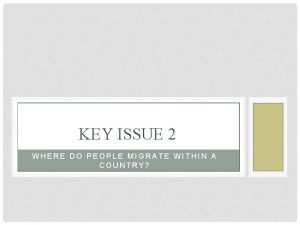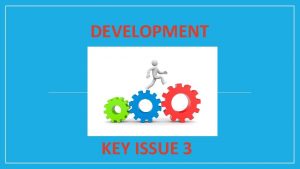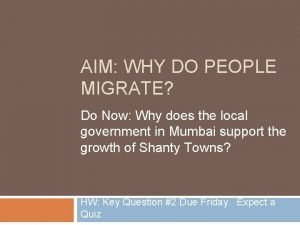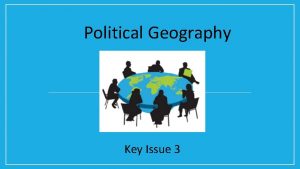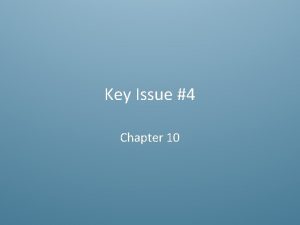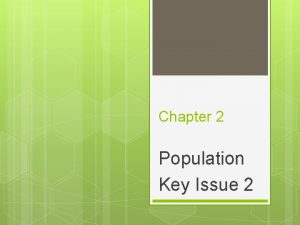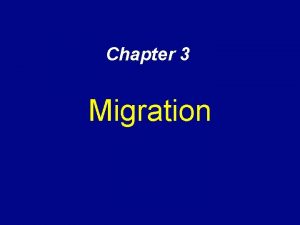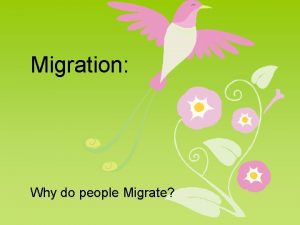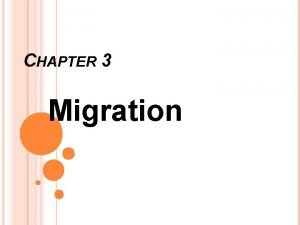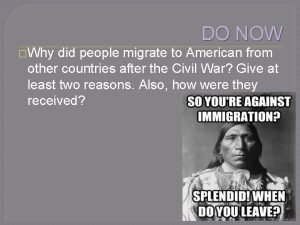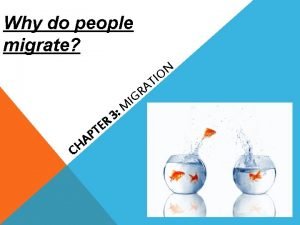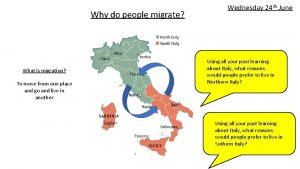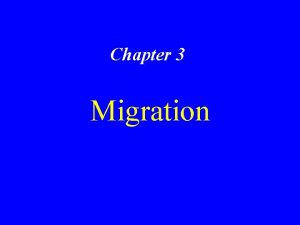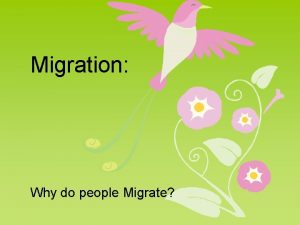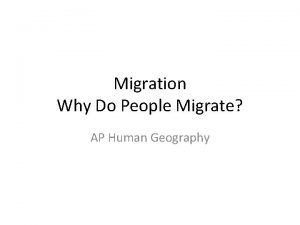KEY ISSUE 3 Why Do People Migrate People












































- Slides: 44

KEY ISSUE 3 Why Do People Migrate?

People decide to migrate because of a combination of two factors. • Push factors induce people to move out of their present location. • Pull factors induce people to move into a new location. PUSH MIGRATION PULL

Three major types of push and pull factors 1. Political 2. Environmental 3. Economic

POLITICAL PUSH FACTORS • Religious Persecution • Political Persecution • Intolerance of dissent • Abuse of power by ruling parties • Racial/Ethnic/Identity-Based Discrimination • Open Violence /Conflict






ENVIRONMENTAL PUSH FACTORS • WATER – Too much OR too little • Global Warming • Deteriorating Land Quality • Natural Disasters • Hurricanes • Floods • Landslides • Volcanoes/Geological Events

Flooding in Jakarta, Indonesia


A FLOODPLAIN is an area periodically inundated when a river floods. They are named for how often it is estimated they flood - i. e. , ‘ 100 year floodplain’.

Former mining town in New Mexico


The Aral Sea in Central Asia

Earthquake damage in Taiwan

Male- Capital of the Maldives Most of the Maldives- and other small island nations- are located only a few feet above sea level. CLIMATE CHANGE threatens to erase these places from the


ECONOMIC PUSH FACTORS • Population Pressure • Weak National Economies • Poor Purchasing Power of Inflated Local Currencies • Poor Job Market • No opportunities for more educated



The attractiveness of a destination region rises and falls along with economic winds. 19 th- Early 20 th Century

DUBAI, UNITED ARAB EMIRATES (UAE)

DUBAI, 1985




RAVENSTEIN’S LAWS � Ravenstein’s laws allow geographers to make generalizations about migration. They ‘govern’ 3 areas: � 1. ) the DISTANCE of migration � 2. ) the REASON for migration � 3. ) the CHARACTERISTICS of migrants

Ravenstein’s laws on DISTANCE OF MIGRATION � Most migration is shortdistance and within the same country. � Long-distance and international migration generally flows toward centers of economic activity.


Ravenstein’s law of REASONS FOR MIGRATION �Most people migrate for ECONOMIC reasons. �Political & environmental factors cause people to migrate- but not as often as economics.


Ravenstein’s law of CHARACTERISTICS OF MIGRANTS �Most long-distance migrants are MALE. �Most long-term migrations is by INDIVIDUALS, not by families or other groups.


� United Nations High Commission for Refugees (UNHCR) recognizes three groups of forced political migrants. 1. A refugee has been forced to migrate to avoid a potential threat to his or her life, and they cannot return for fear of persecution.

2. An internally displaced person (IDP) is similar to a refugee, but they have not migrated across an international border.

2. An asylum seeker is someone who has migrated to another country in hope of being recognized as a refugee.

• All of these terms differ from the more general name ‘MIGRANT, ’ which refers to someone who has chosen to leave their home in search of a better life. • REFUGEES are granted special protections in many countries, while MIGRANTS are often given a far less warm welcome.


© 2014 Pearson Education, Inc.

One last category- • CLIMATE REFUGEES (also called environmental refugees) are people FORCED to flee by natural disasters or global warming. • Even though they were FORCED to migrate, they ARE NOT ENTITLED TO THE SAME PROTECTIONS AS TRADITIONAL REFUGEES.


EXIT SLIP QUESTIONS (5 pts) �SOCRATIVE. COM �‘Limeburner. Room’ (One word)
 Dubai 1985
Dubai 1985 Chapter 3 key issue 1
Chapter 3 key issue 1 Key issue 2: where do people migrate within a country?
Key issue 2: where do people migrate within a country? This is why people migrate aj+
This is why people migrate aj+ Why do people preserve local languages
Why do people preserve local languages Why did the mormons migrate to utah
Why did the mormons migrate to utah Cedar waxwing bird
Cedar waxwing bird Pictures
Pictures Key issue 2: why are situation and site factors important?
Key issue 2: why are situation and site factors important? Why do services cluster downtown
Why do services cluster downtown Key issue 1 why are downtowns distinctive
Key issue 1 why are downtowns distinctive Chapter 9 key issue 4
Chapter 9 key issue 4 Key issue 3 why do individual languages vary among places
Key issue 3 why do individual languages vary among places Why are different places similar geography
Why are different places similar geography Key issue 3 why are different places similar
Key issue 3 why are different places similar Key issue 4 why do migrants face obstacles
Key issue 4 why do migrants face obstacles Key issue 4 why do migrants face obstacles
Key issue 4 why do migrants face obstacles Key issue 3 why do some places face health challenges
Key issue 3 why do some places face health challenges Key issue 4 why are some actions not sustainable
Key issue 4 why are some actions not sustainable Key issue 3 why does population growth vary among regions
Key issue 3 why does population growth vary among regions Key issue 4 why are some actions not sustainable
Key issue 4 why are some actions not sustainable Migrate network address translation
Migrate network address translation Do hedgehogs hibernate or migrate
Do hedgehogs hibernate or migrate Azure migrate demo
Azure migrate demo Migrate journal mailbox to office 365
Migrate journal mailbox to office 365 Drupal migrate d2d
Drupal migrate d2d Siebel vs salesforce
Siebel vs salesforce The us center of population has moved steadily to the
The us center of population has moved steadily to the Microsoft virtual academy
Microsoft virtual academy Migrate definition
Migrate definition Migrate from customerhub
Migrate from customerhub Do hedgehogs hibernate or migrate
Do hedgehogs hibernate or migrate Dont ask
Dont ask Which key activities do partners perform
Which key activities do partners perform Contoh bisnis model canvas makanan pdf
Contoh bisnis model canvas makanan pdf The renaissance and reformation section 3 quiz answer key
The renaissance and reformation section 3 quiz answer key What is fair trade coffee why is it an ethical issue
What is fair trade coffee why is it an ethical issue Most affected people and areas
Most affected people and areas Who are affected by the problem
Who are affected by the problem Key issue 2 where are inequalities in development found
Key issue 2 where are inequalities in development found Chapter 13 key issue 4
Chapter 13 key issue 4 Key issue 1: where are services distributed?
Key issue 1: where are services distributed? Chapter 12 key issue 4
Chapter 12 key issue 4 Chapter 11 key issue 4
Chapter 11 key issue 4 Key issue 1: where did agriculture originate?
Key issue 1: where did agriculture originate?
